A Ramble in Bidddenham in 1879

Looking from Duck End Lane to Church End March 2012
The following article, part of a series of rambles around different Bedfordshire parishes, appeared in The Bedfordshire Times on 7th June 1879.
If I wished to show an "intelligent foreigner" a good specimen of a characteristic English village, I could do no better than to take him to Biddenham. It would not much matter whether we went along the Bromham road or through the meadows from Ford End. Either way would be about equally characteristic and equally interesting to our imaginary friend. I don't believe there are any meadows in the world just like our English meadows, and the meadows between Ford End and Biddenham village are very pleasant examples of the English species. Again, nothing can be more completely English than the broad, firm, hedge-bounded, and tree-bedecked from road, meandering with an indolent capriciousness through corn fields and pastures, and then shunting the wayfarer to the left by a lane or a field path, into one or the other end of Biddenham street.
And my "intelligent foreigner" ought to accompany me just now. A month ago the trees would have been almost bare; a month later the nightingales will have left off singing. At this present time the picture or rather pictures that I could show my Continental friend would be peculiarly fresh and rich. The lush grass is now green with a depth and fullness of colour which will be lost in a few weeks. The foliage of the trees is young and untarnished: the leaves have the charm of youth upon them, and have not yet had their brilliance toned down into the lustreless tinge of maturity. The hawthorn hedges, too, have at has succeeded in bursting into blossom; and their banks and ditches are buried deep beneath a growth of herbage that is too little noticed because it is so common. But let any one who has studied nature without losing the child's heart, take a walk to Biddenham and try to look at the hedges and ditches as if they had never seen them before: and indeed, this is the way to view things as they really are . Such an observer will find now a score of plants, which are as worthy of notice as they are common, luxuriantly spreading over the dirty hedgesides and covering the muddy ditches with beauty. There is the stinging-nettle side by side with the white dead-nettle, the two looking so much alike – except for the white blossoms of the latter – that the casual observer would find it difficult to say at a glance which was which. And yet they are plants that are no more akin than is the hop to the red dead-nettle or to the blue-flowered ground ivy all of which may also be seen in a walk to this village. Then there is the large goose-grass, or cleavers, or whatever else the Bedfordshire people may call it, which is now stealing fast up the hedges, and will soon twist itself into myriads of tangles. The chervil and other umbels are spreading out their delicately carved leaves and their still more delicately fashioned bunches of flowers. In one walk the other day, of which Biddenham was the central point, I saw at least three kinds of speedwell in flower, as well as three wild geraniums, the white bryony beginning to stretch out its long tendrilled arms, the stitchwort brightening the hedges with its clear white stars, the clary – a plant not everywhere to be found – growing in profusion along the roadside bank, the young teasle with its lead-stalk cups full of water, and a host of others which it would be tedious to mention, but which it is very interesting to linger over in a sunny saunter.
But these are features more or less common to every country ramble. It is not every place, however, which possesses the rural charms of the neighbourhood to which I am referring. Too many villages bear a painful resemblance to detached fragments of the dirty suburbs of towns. Narrow streets, raggedly paved, cottages built in long dismal rows by men who have a genius for creating ugliness, and squalor which makes it hard for the visitor to resist his pessimistic tendencies, - these things I have seen in too many. But at Biddenham the visitor feels that he is veritably in the country. Broad stretches of grass lie along the village street, and pleasant flower-beds make picturesque foregrounds to the cottages. Little houses that have no architecture to boast of can show porches of greenery and ivied walls. The larger houses that are scattered about rather numerously are half-hidden behind bowery gardens that must have demanded the loving care of several generations. That old wall with its lichens and ivy-leaved toad flax, under the evergreens and the laburnum, where the peep through the living archways shows the large periwinkle in full flower at the base of the house; that verandah of ivy and climbing plants shading one front of the comfortable English homestead, half of which bends at a right angle upon the other, and makes a cosy sheltered space between the fence and the door; that sedater house, standing in its quiet dignity more remote from the street, with a wide space of lawn and shrubbery besides a high hedge that was not grown in a day between the observer and itself, - these are pictures I have brought away with me. There are new houses, too, which make no difficulty in fitting themselves in as consistent and integral parts of the harmonious whole. I must not forget the open meadow through which lies the footpath to the church, and at one end of which some very young ducks and almost equally young tadpoles are just now passing through their earliest experiences of life. Here I saw the first respectable show of buttercups and daisies which my rambles this season discovered to me; and here I caught my first distant glimpse of Bromham park with its church tower, which I mistook for a castle ruin among the trees. Altogether I felt that though Biddenham is not violently picturesque like many villages in – say – Wales and Devonshire and Cornwall, nor architecturally noteworthy like the show places of some of our noblemen, nor specially historic like Elstow for example, yet it is a place which would excellently well serve as the locality with which to connect an idyll, or even in which to experience one. And I cannot help holding it as a part of my aesthetic creed that the quiet rustic charm of such places very materially, if perhaps unconsciously, affects the character of the emotional dramas in which the inhabitants are perforce actors. And I hold this article of creed along with and notwithstanding another, viz., that to enjoy to the full the sweet countryside, one must come either direct from a town life, or must have had a good long course of town dwelling, to give zest to the enjoyment of the beauties which, as Heine says of nature's artistic work generally, are made up of nothing but "a sun, trees, flowers, water and – love!"
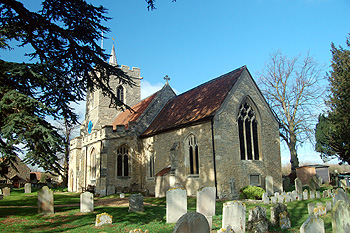
The church from the south-east March 2012
As the visitor to the church must fetch the keys from the cottage in the meadow, opposite the new house of Mr. C. Howard's, he will naturally have to approach the church along the lane which gives a S. E. view of the neat little building. At present the lime trees skirting the graveyard help the tall yews to hide all but the roof and the tower. The picture is certainly a pretty one. The modest spire rising from the battlemented tower, the sharp gables of the nave and chancel, the bright green of the limes and the darker tones of the yews, the little group of cottages looking like an obsolete house of good position on the right [immediately opposite the east end of the church, long since demolished], the quaint range of farm buildings with the covered entrance to the farmyard on the left [Church Farm], all form harmonious details in a sense very pleasant to one who is in search of the picturesque.

Church Farm March 2012
The gate to the yard, on the south side, opens upon the angle formed by the two paths, where is placed an old stone which must have been either the base of a pillar of a village cross, but which now bears a geranium in flower.
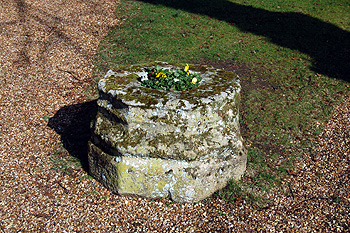
Cross base March 2012
The south porch has a stone seat on the east side, forming a pleasant waiting place for service in summer whatever more official uses it may once have had.
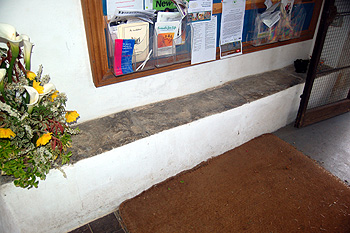
The stone bench in the south porch April 2012
The wall of the south chapel is battlemented, and with the chancel – in which is a priest's door – is partly covered in ivy.

The south porch March 2012
Most of the windows are Perpendicular; but the eastern window of the chancel is Decorated. There appears to have been a door in the tower on the south side, but it is now built up, and the tower is entered by a modern flight of stone steps on the north side leading through a doorway – which is also evidently modern – into the clock room, immediately below the bell loft.
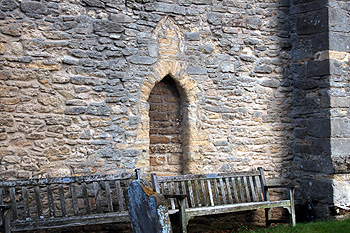
Blocked doorway in the south wall of the tower March 2012
The six bells, as well as the clock date – in their present form at least – from 1787, when they were placed where they are by one and the same benefactor. One of the bells tells us that "Five old bells were cast into six at the expense of John Brooks". All the bells bear the name of William Emmerton, of "Wooten", as the maker. One has the additional legend "Be light and glad, in God rejoice" and another "Blessed is the name of the Lord". Both the tower and the south side of the church retain in the gargoyles striking evidence of the medieval genius for sculpturing the grotesquely ugly. A south door near the west end of the north aisle still remains in the outer wall; but inside, recent restorations have closed it.
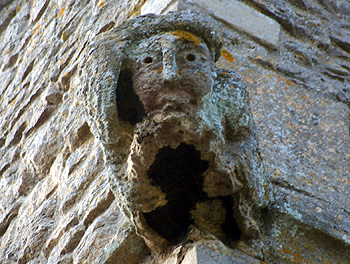
Carving on the north-east corner of the tower March 2012
On entering the church – which is dedicated to St. James – by the south porch, the visitor at once sees the tall octagonal font with its carved panels, and shield-bedecked pedestal.

The font March 2012
The lower part of the tower forms a continuation of the nave, through a pointed arch, and is fitted with a raised gallery for the Sunday School children. Against the north pier of the arch stands the harmonium which leads the singing. The interior of the church shows traces almost everywhere of recent restoration and repair, and the east wall of the chancel remains perfectly bare and plain. The chancel floor is neatly paved with encaustic tiles, and the vertical surface of the step leading to the altar-place bears the legend "I will not leave you comfortless. I will come to you". The chief features of interest in the altar-place is the old tapestry altar cloth, dated 1549, and having in two corners the word ROLOFUOS. A piscina, with a scalloped basin, forms a niche in the south aisle or chapel.
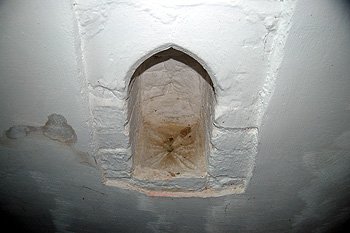
The piscina in the south aisle April 2012
The chancel opens into the nave under a Norman arch, which has a modern look about it.
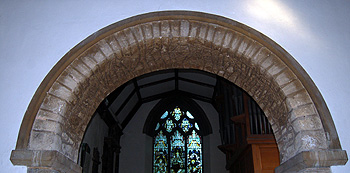
The chancel arch March 2012
A screen now stands in the north aisle, cutting off a small space at the end for the purposes of a vestry. The fretwork at the heads of the panels, which are now filled in with crimson cloth, is singularly varied, and it is difficult to find any law regulating the variation. This screen is said to have stood in the chancel, but it is much too large for the west end of the chancel, unless that west end has been modified. The wall flanking the Norman arch must, however, be older than the Reformation, as it contains on each side a large "squint", or oblique opening, through which the elevation of the host was visible to the worshippers west of the arch.

Squint into the north side of the chancel March 2012
The screen may have been placed east of the arch after the Reformation, when the elevation of the host was no longer an important part of the worship. If there is no historical evidence of the original position of the screen, I would suggest it might have divided the south chapel from the nave [as it does today].
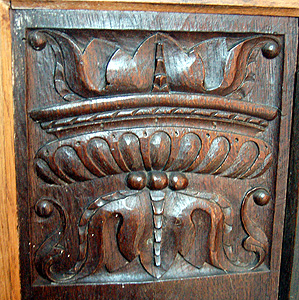
Detail from the south chapel screen March 2012
That chapel is entered by a single segmental pointed arch spanning a space about equal to the width of the screen. The north aisle has two arches, with corbels borrowed from the armorial bearings of the Botelers of Biddenham and the Dyves of Bromham.
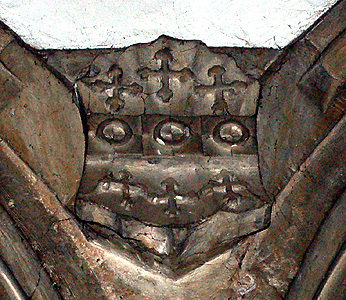
The Boteler arms between arches in the north arcade March 2012
The chancel arch has at present a decoration of white letters on a scarlet ground containing "God, even our own God shall give us his blessing". In the screen-formed vestry is a long oaken chest, iron-bound, which I believe contains some old Black Letter books. The reading desk and pulpit stand on the north and south sides respectively of the chancel arch, and are of oak. The pulpit has some well-executed vine and leaf carving under the upper moulding.

Decoration on the pulpit April 2012
The whole of the church is seated with solid oak benches, which are comfortable to sit upon as well as pretty to look at. Dropping in one Sunday afternoon in quite an unpremeditated way, I found the whole character of the place and the service such as could not fail to give a calm pleasure to anyone prepared to sympathise with the Church of England and its ritual. It is certain that very few of the attendants at village churches are much affected by the theology of Church; what touches them, and educates the religious side of their nature, is chiefly the genuine humanity of the teaching and the devout refinement of the liturgy. This is at least what I felt – and I say this without prejudice to my complete theological colourlessness as a "Rambler" – when I was sitting in the pleasant little old building at Biddenham. Moreover, I sat watching the bright foliage outside gracefully bowing to and fro against the background of an early summer sky, and was decidedly glad that the windows were glazed with clear glass, and that the work of the true artist, nature, and not the old-world grotesquerie of stained lights, was mingled with my thoughts.
But I must take my readers again into the graveyard, and before I allow them to leave it, I must draw their attention to the garden-like aspect of the north-east corner, heightened by the ivy covered wall of the cottages which bound it to the east [now demolished]. On the old low stone wall of the yard, I found for the first time this year the little wall saxifrage (Saxifraga tridaclylites) in blossom, with a host of specimens of the vernal whitlow grass, a small speedwell, and other little wall favourites which lovers of nature are so ready to welcome.
![Biddenham School in 1956 from the Women's Institute scrapbook [X535/6]](/CommunityHistories/Biddenham/BiddenhamImages/Biddenham School in 1956 from the WI scrapbook [X5.jpg)
Biddenham School in 1956 from the Women's Institute scrapbook [X535/6]
The National School was keeping its Whitsuntide holiday when I sought admittance; but I found the schoolmistress at her father's, the host of the neat inn of the village, the Three Tuns.

The Three Tuns March 2012
From Miss Felts I learnt that the average attendance of children was about 40 out of about 50 on the books. The older part of the school building appears to have been built between 30 and 40 years ago, previous to which time the village youths were taught at a dame's school. The western part of the present building is, however, more recent, and has been added since the induction of the present vicar, the Rev. Henry Wood.
In a population of less than 400 there is not scope for much shop-keeping energy. I learnt from a child, whom I induced to act as my guide, that there were two shops in which, to her knowledge, "sweeties" could be bought. A stands coyly ensconced in a grove of trees not far from the roadside. These with the inn already mentioned seem to comprise nearly all the commercial industry of the place. Biddenham is, however, one of the villages in which pillow-lace is still made. There is nothing to be seen to suggest the contraries of industry, sobriety, and cleanliness; it would be well for England if Biddenham could be taken as a fair representative of all its villages.
![Biddenham lacemaker Mrs. Webb from the Women's Institute scrapbook [X535/6]](/CommunityHistories/Biddenham/BiddenhamImages/Mrs Webb - lacemaker about 1950 from the WI scrapb.jpg)
Biddenham lacemaker Mrs. Webb from the Women's Institute scrapbook [X535/6]
I must dismiss with a mere mention of it, the old workhouse, as it is called, at Ford End [the site is now in the Borough of Bedford], but which is really the remains of the Boteler mansion [demolished about 1960].
![Ford End Manor House about 1910 [X306/92/1]](/CommunityHistories/Biddenham/BiddenhamImages/Ford End Manor House about 1910 [X306-92-1].jpg)
Ford End Manor House about 1910 [X306/92/1]
I must leave the scientific student who wishes to learn about the Roman antiquities and the flint implements which – the latter at least – have made this little village famous throughout Europe, to consult the interesting papers published by the Bedfordshire Archaeological Society. The picturesque near Bromham must be noticed when I go further afield and extend my rambles to that village.

Bromham Bridge September 2007
And the tameness of my description of the pleasant country side must be allowed to serve only as an inducement for the reader to spend his leisure in strolling over the same ground himself. The man who is tired of the routine of office or shop, and longs for rest and calm, will find there some suggestion at least of Thompson's lines – "… nought around but images of rest, Sleep-soothing groves and quiet lawns between".